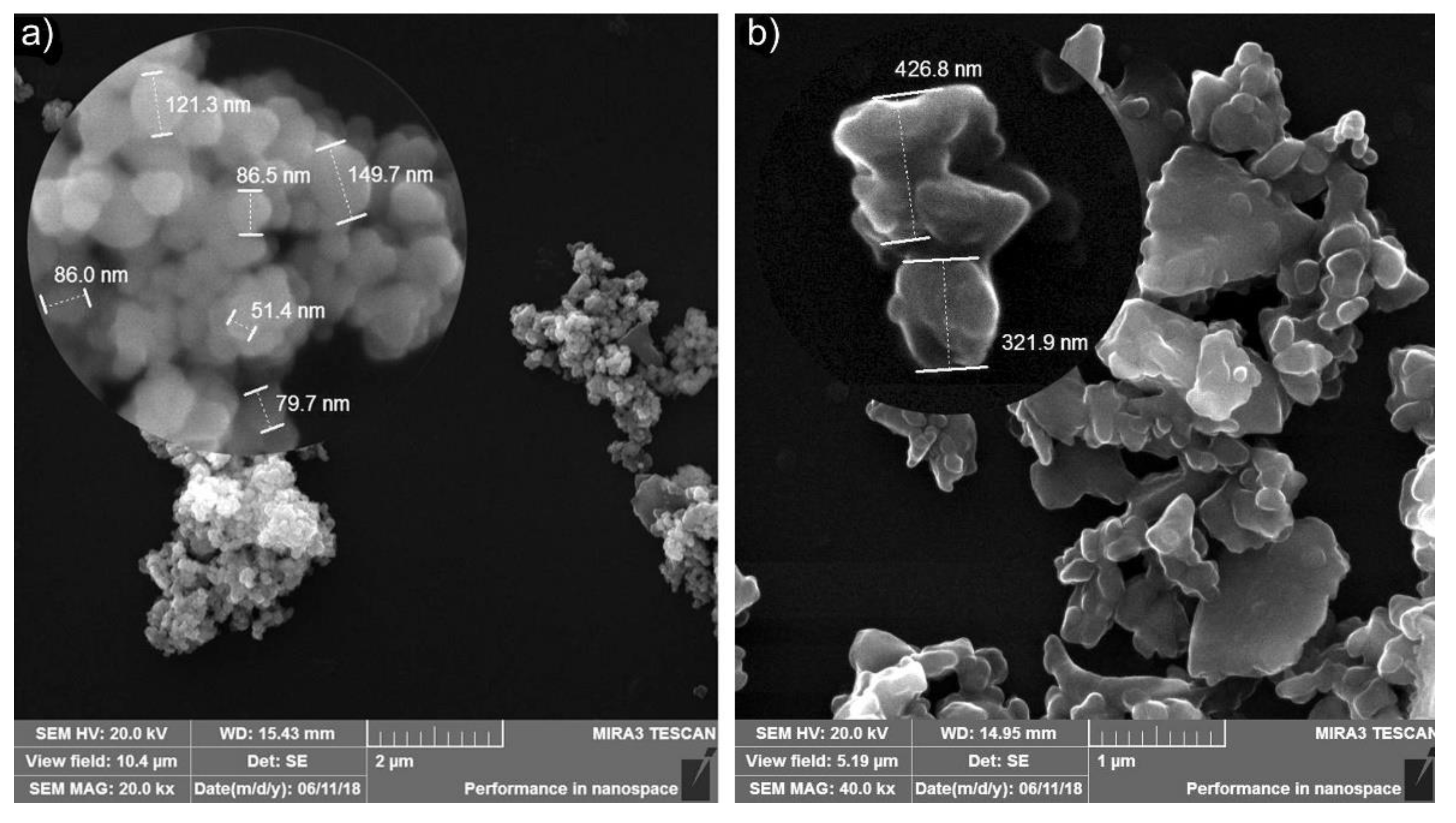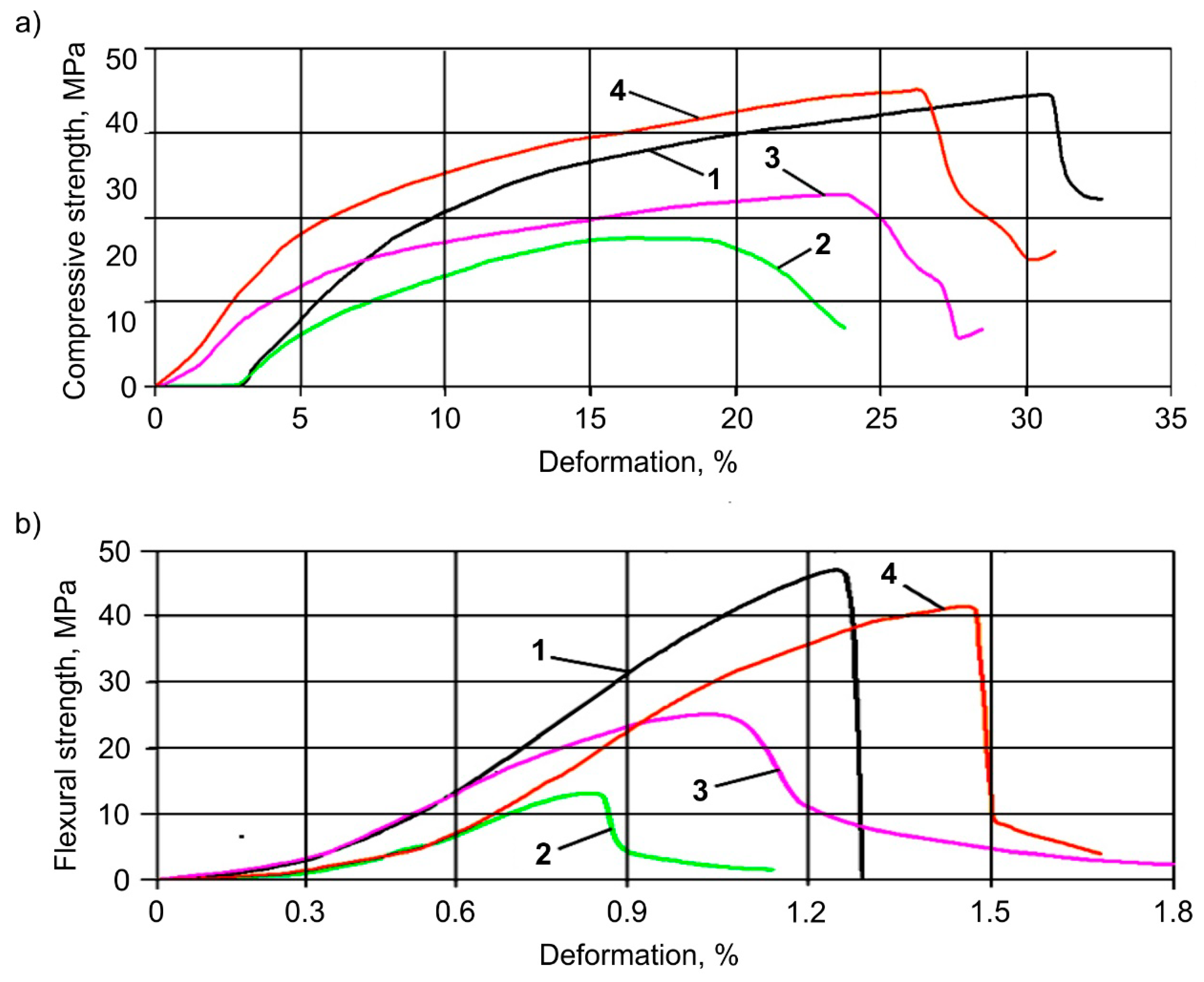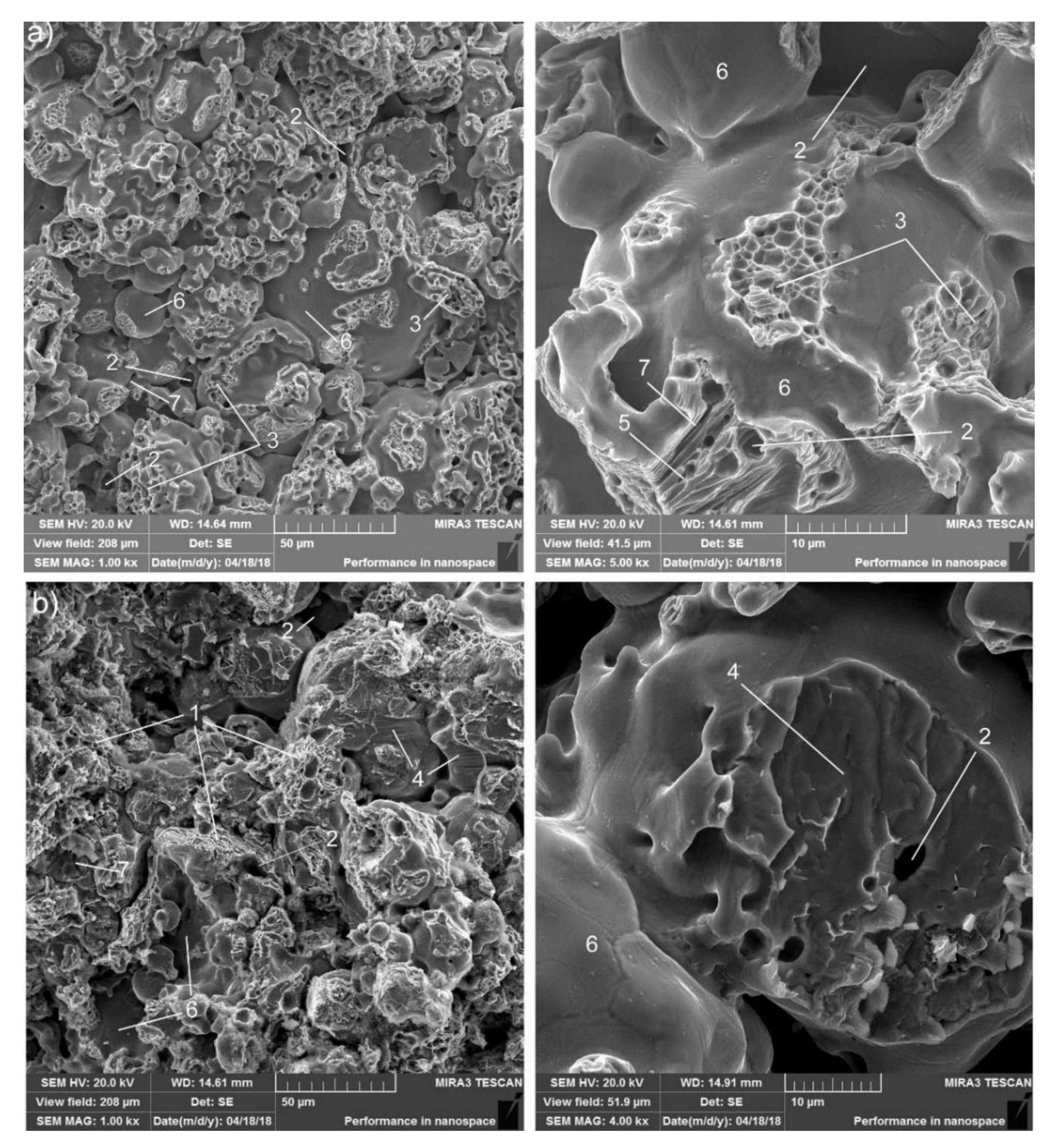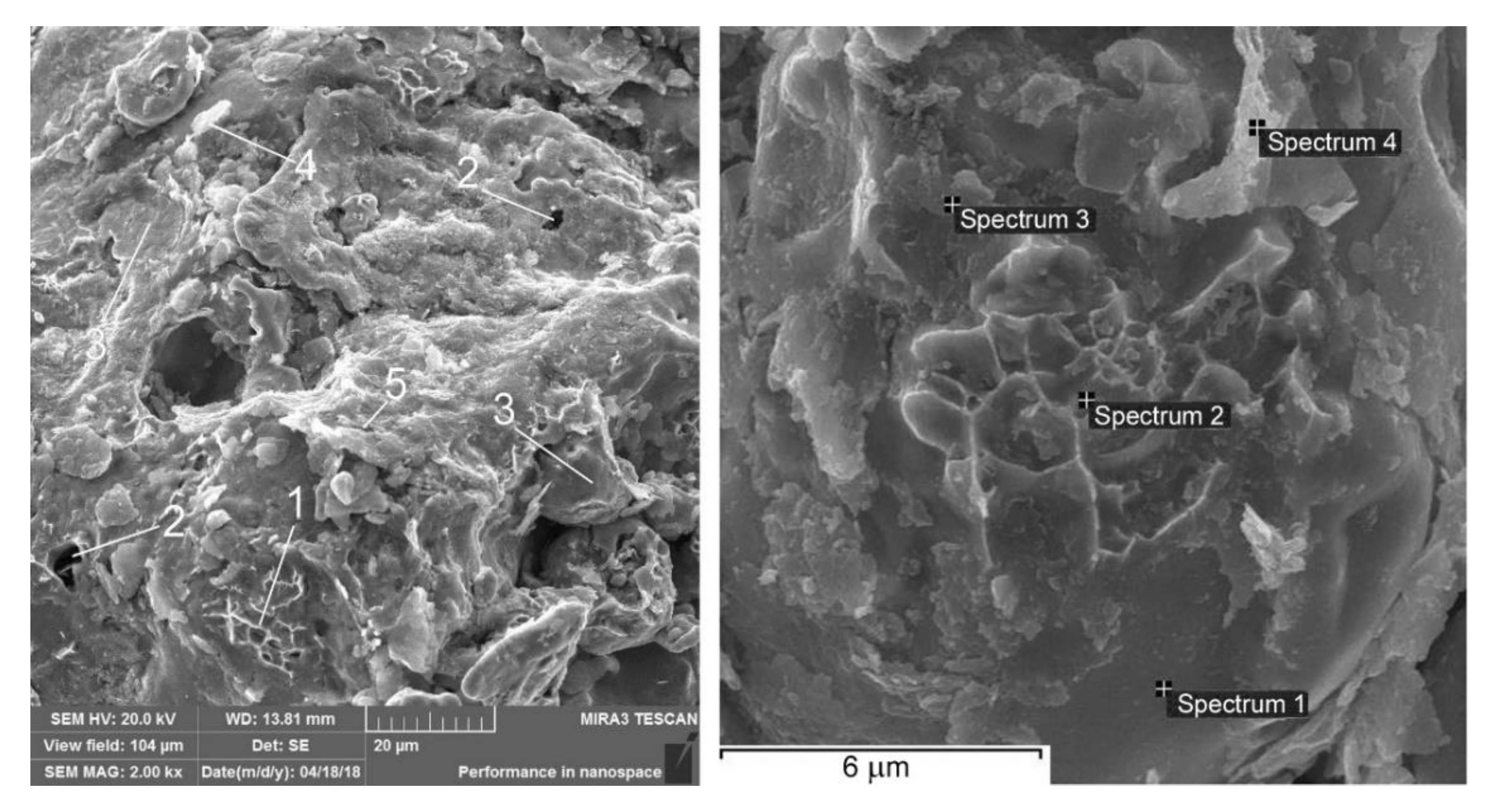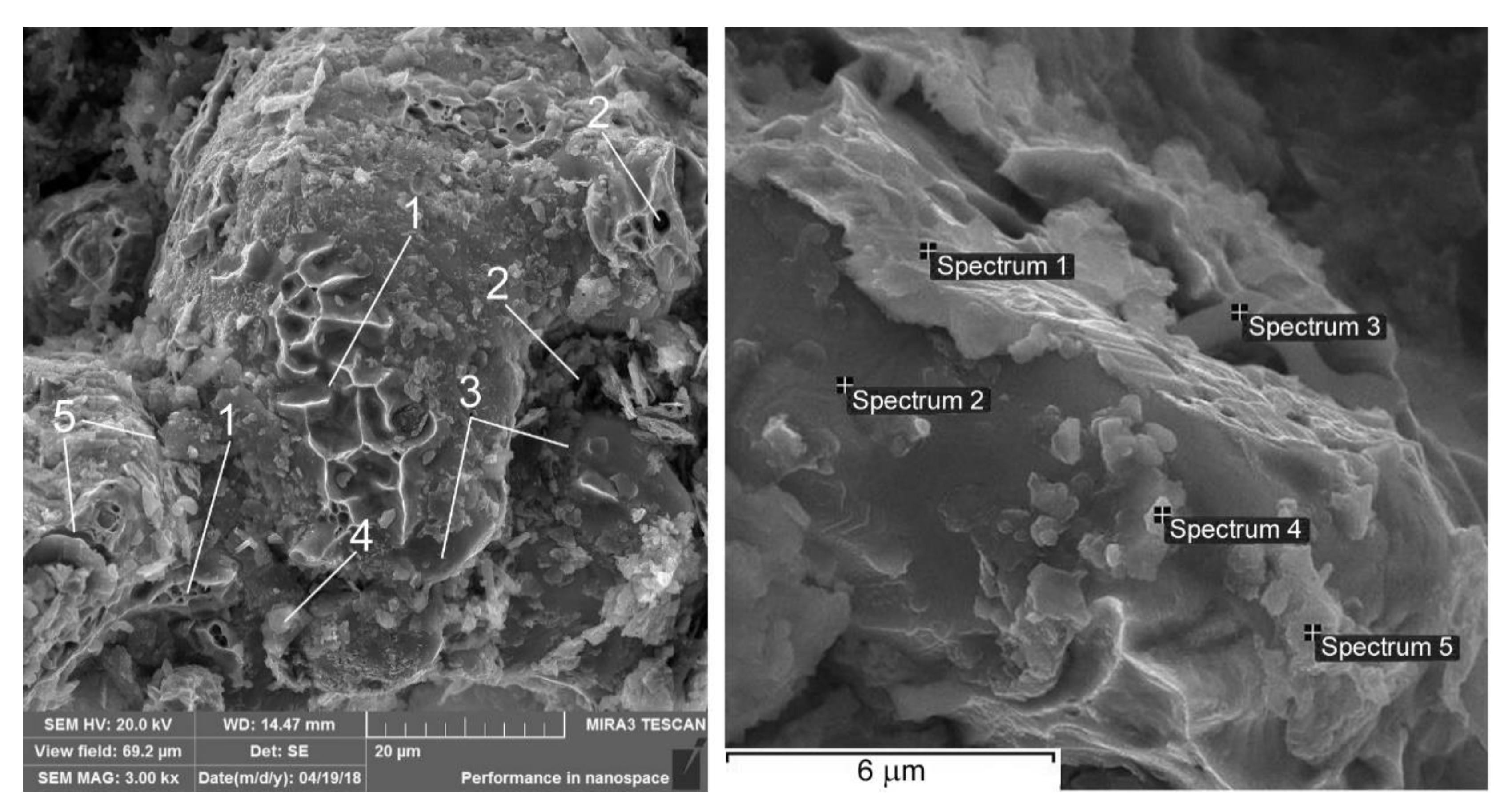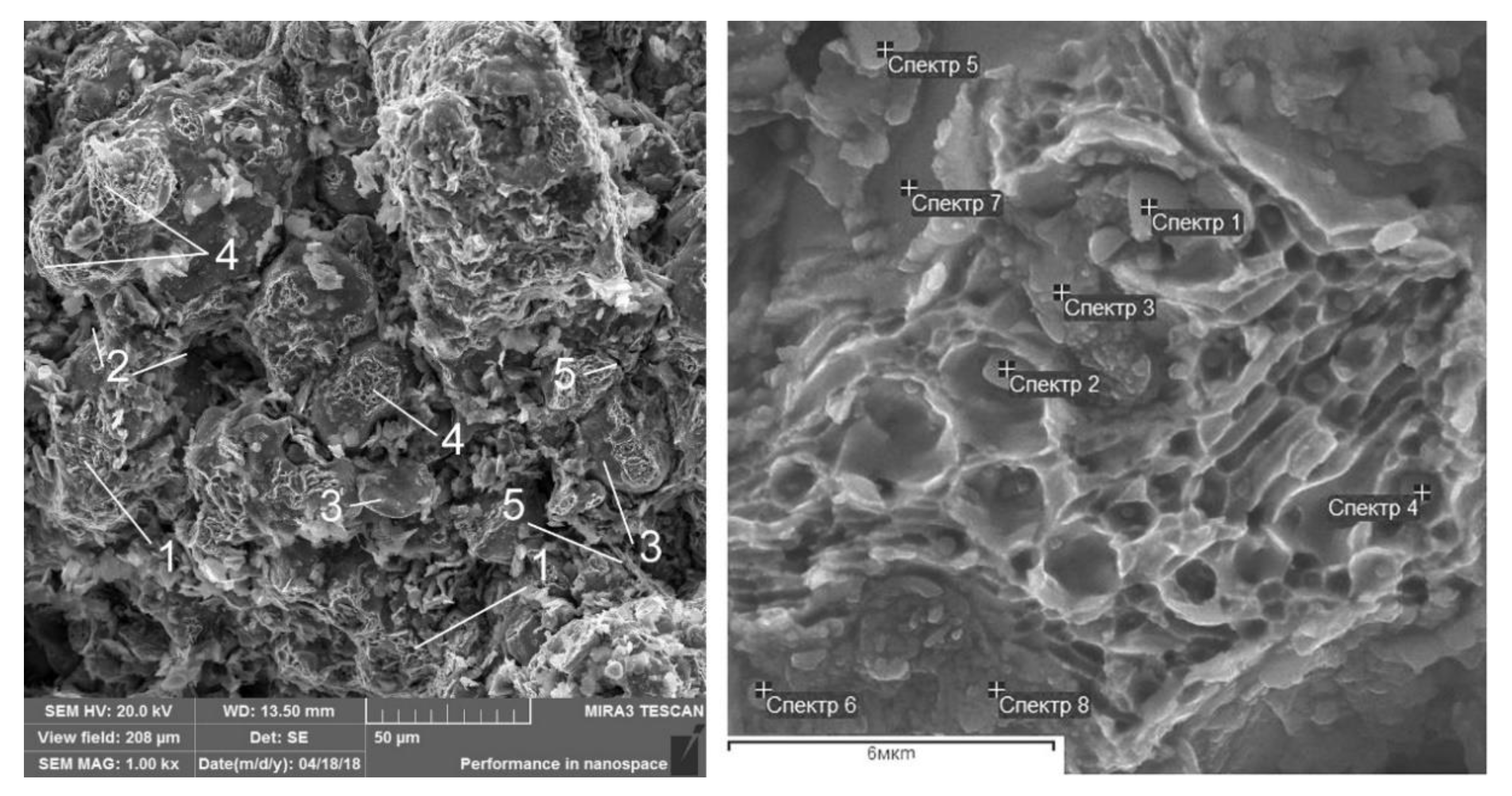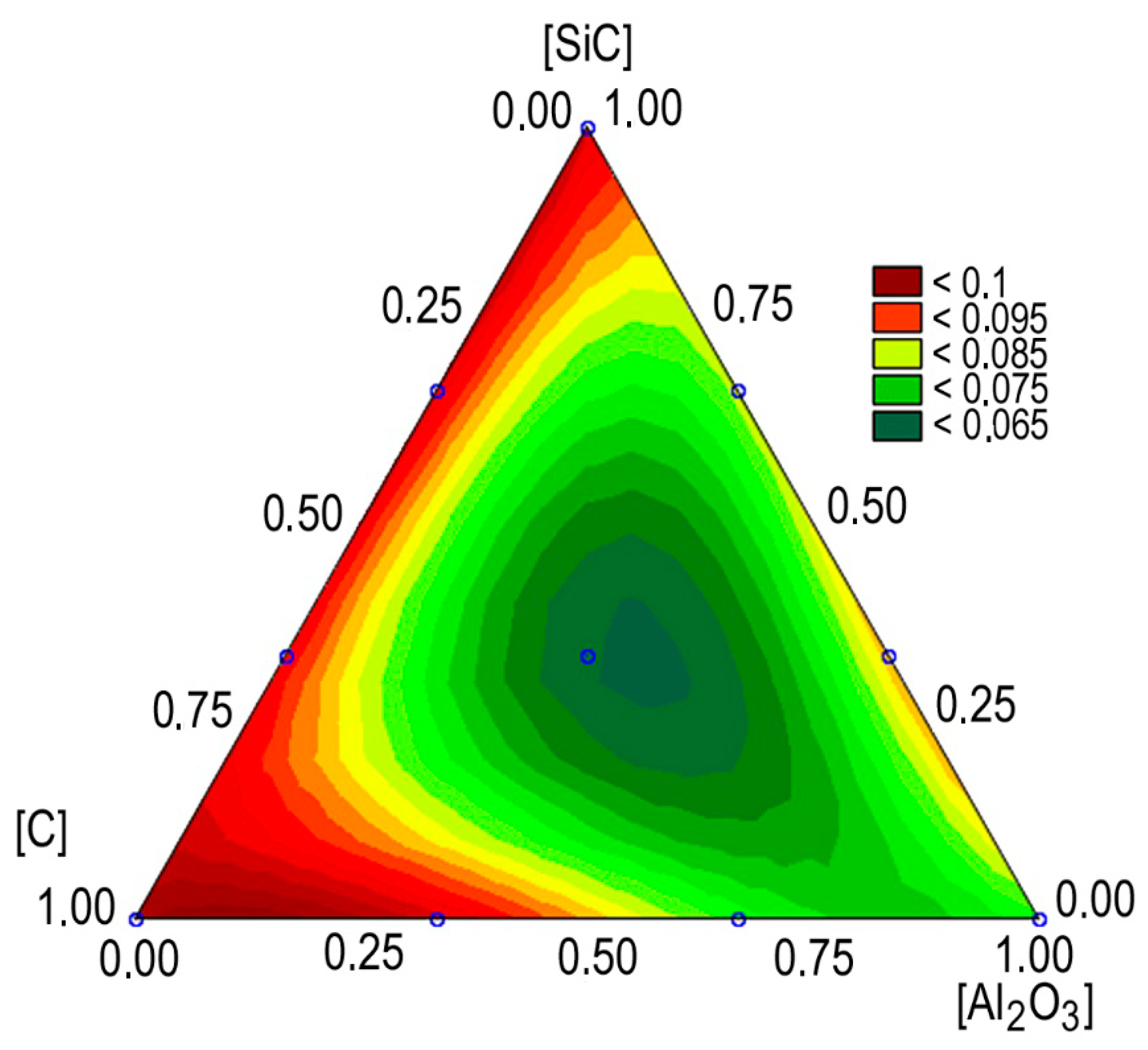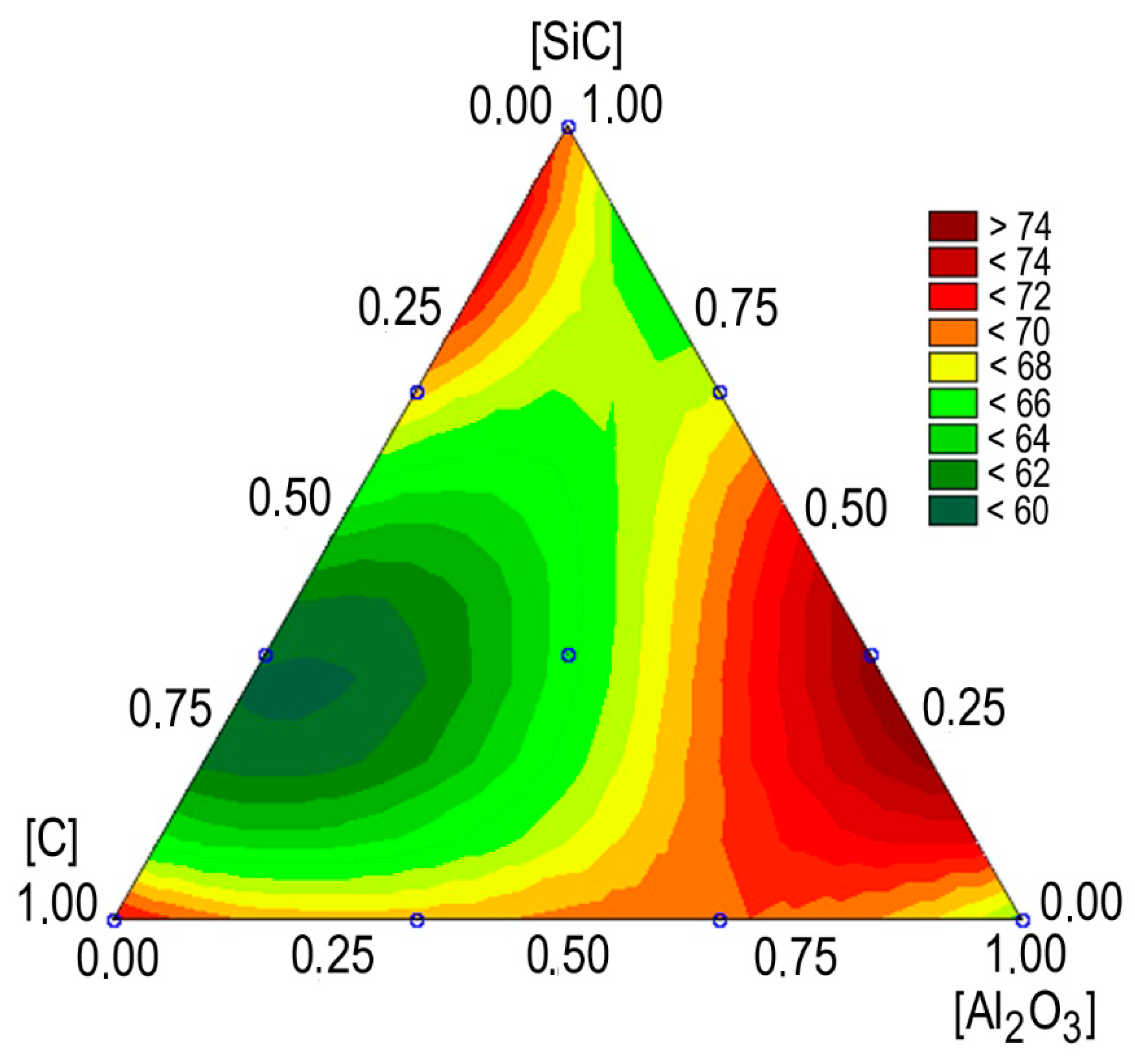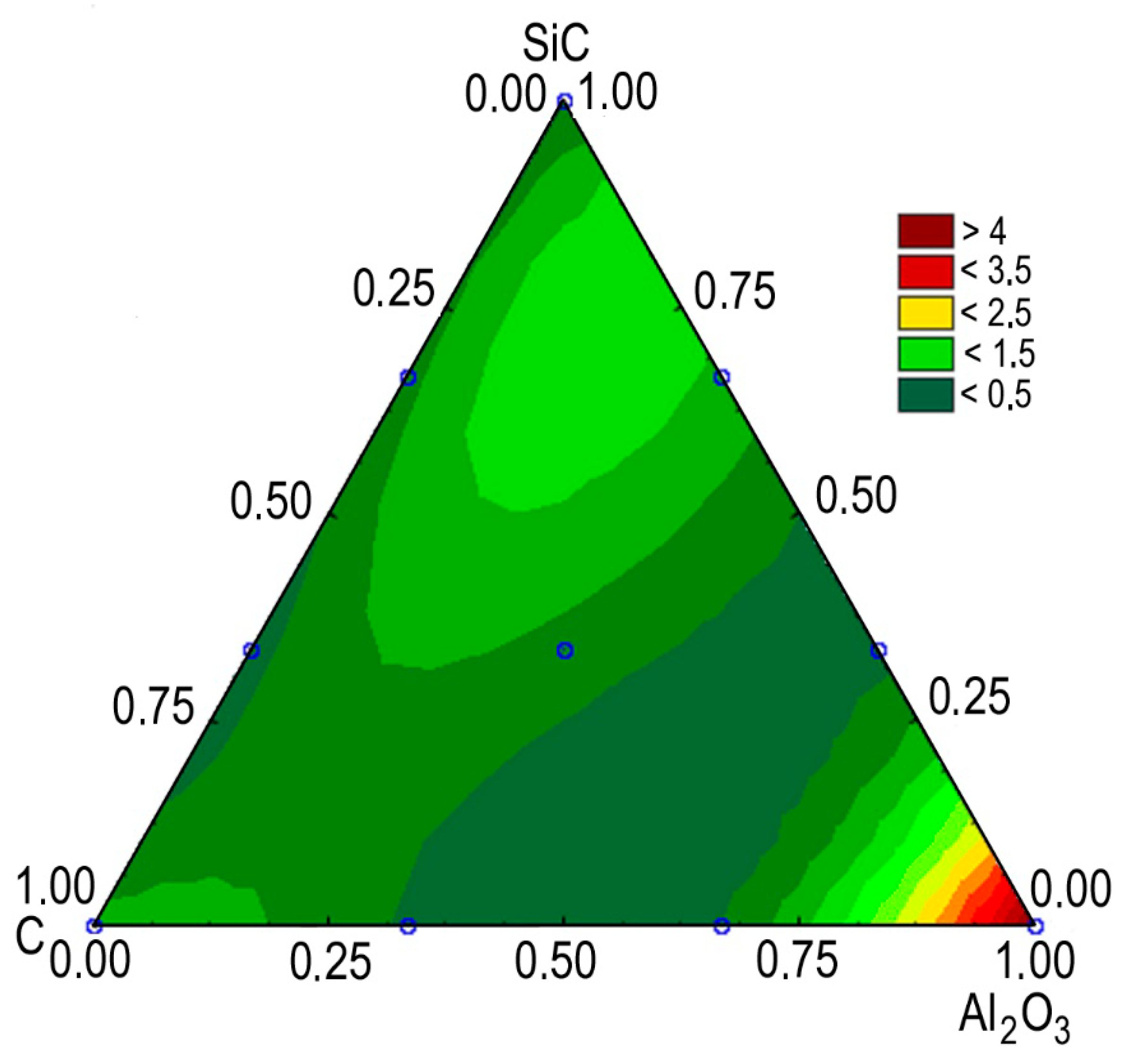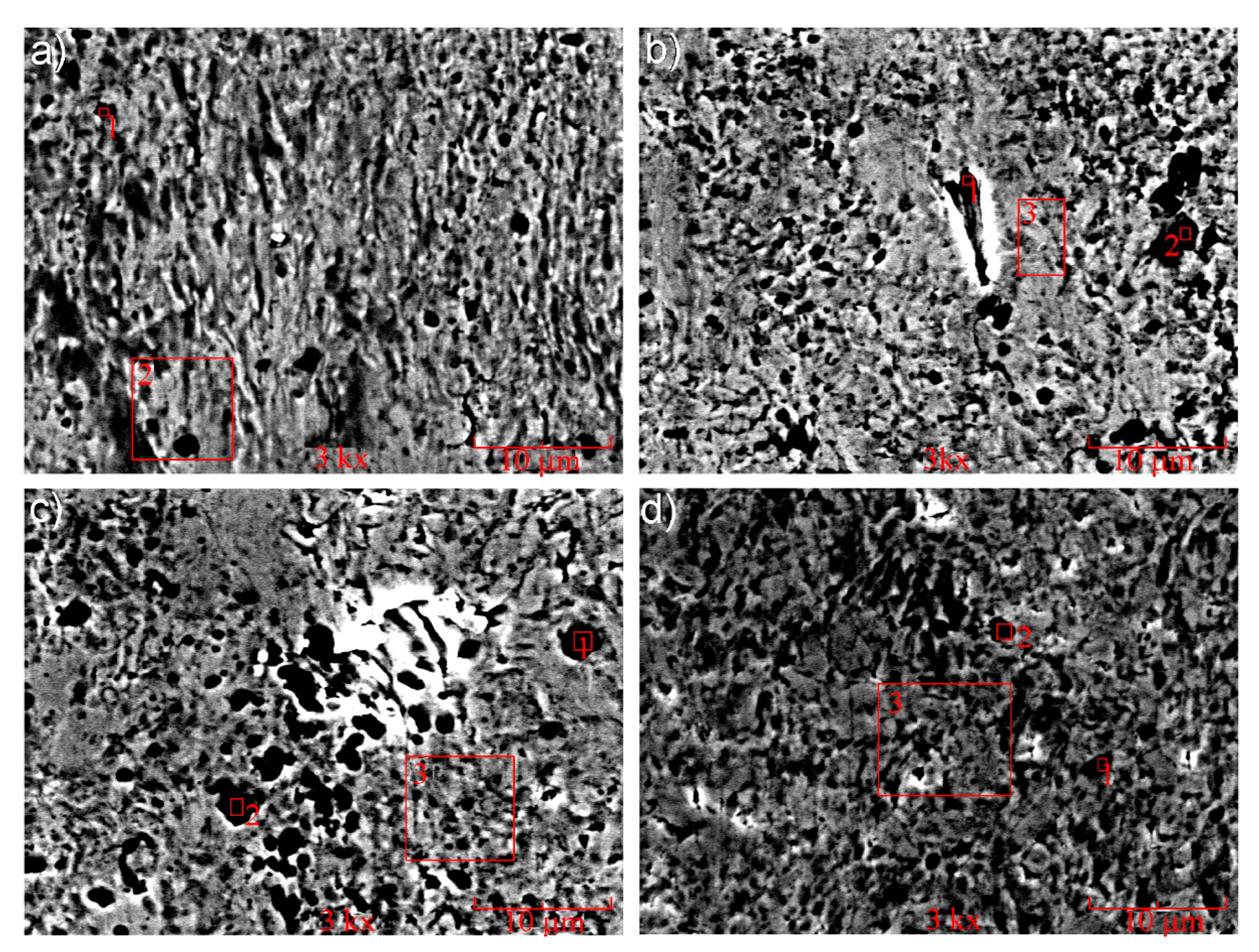1. Introduction
Composites are important in the development of many industries, particularly transport, engineering, or military technology. As a base material, polymers, metals, and various ceramics are used. Aluminum, titanium, copper, and iron are widely used as the matrix of metal-based composites. According to Chaudhari and Singh [
1], different oxides, particularly alumina Al
2O
3, zirconia ZrO
2, silica SiO
2, tungsten oxide WO
3, chromium oxide Cr
2O
3, titanium oxide TiO
2, yttria Y
2O
3, and many others, can be used as hardening additives. On the other hand, different carbides, particularly SiC, WC, B
4C, and TiC, have been in widespread use for a long time. Reinforcing additions may be used as separate particulates, as particulate complexes, continuous fibers, short fibers, or whiskers.
Composites based on aluminum are in widespread use in mechanical engineering. It was found by Bharath et al. [
2] that the introduction of Al
2O
3 particulates in Al-based materials provided a good distribution of particulates in the materials studied. Increasing the content of alumina particulates ensured increases in the hardness and tensile strength of metal-matrix composites (MMCs). The Al
2O
3 particulates located in the Al matrix composites significantly increased their wear resistance. Pramanik [
3] revealed that these particulates prevented the abrasion and limited surface deformations of materials. The occurrence of alumina particulates and their sizes are the most significant factors when affecting the fatigue strength of Al-based composites, as it was shown by Pramanik et al. [
4]. Larger particulates hindered the growth of cracks or changed their movement. Selvakumar et al. [
5] considered Al–Cu composites with SiC additives. It was shown that with an increase in the content of silicone carbides, the microhardness and compression strength increased, but the thermal conductivity decreased. Wear resistance increased with increasing SiC content. According to Pramod et al. [
6], composites based on Al7075 alloy with Al
2O
3 additives showed an increase in the ultimate load and friction path compared to the base aluminum alloy. Nonlinear dependences of the density, friction path, and wear on the weight content of alumina were revealed. Studies of Al-based MMCs with Al
2O
3 particulates described by Kumar et al. [
7] revealed the presence of silicon in the needle formed at the grain boundaries of the matrix. It was shown that with a decrease in the size of alumina, the tensile strength and hardness of composites increased, but at the same time, the relative elongation decreased. The presence of alumina affected the wear resistance of composites studied, and while reducing the Al
2O
3 size, the resistance to wear increased. It was shown by Kumaraswamy et al. in [
8] that the introduction of alumina, silicon carbide, and boron carbide into the Al-based matrix allowed the improvement in the basic mechanical properties of composites, wear and abrasion resistance, crack resistance, and many other characteristics.
Nanoparticulates are used increasingly in MMC production because they provide better properties of composite materials. Mechanical, tribological, and microstructural properties of the aluminum alloy reinforced by Al
2O
3 nanoparticulates with different weight contents were tested by Raturi et al. [
9]. Properties tested were better compared to composites with the addition of microparticulates. It was described that when the content of nano-Al
2O
3 increased, they became more agglomerated and the residual porosity increased. The size of nanoparticulates in a metal matrix affects the MMC properties significantly, as it was revealed by Hassanzadeh-Aghdam et al. [
10]. More dispersed particles lead to the improvement in these properties. Therefore, the conglomeration of nanoparticles is extremely undesirable, although it has been observed in a number of cases.
Composites based on iron and its alloys are much less studied. This is primarily due to the areas of such composites used—such as antifriction materials or materials with special properties. Composites based on an iron–chromium alloy with additions of Al
2O
3 particulates were considered by Saidatulakmar et al. [
11]. Research results have shown that the best alumina content, when microhardness and wear resistance increase, is 20%. With its further increase, the phenomenon of agglomeration was observed, which worsened the interaction between the matrix and the additive.
Feldshtein and Dyachkova [
12] described features of the structural, mechanical, and tribological properties of MMCs with ultrafine additives. Hard nano-additives in the base material increased its strength 1.5–3-fold. In comparison to the base material, coefficients of friction of MMCs were decreased 2–3 times, the seizure pressure was increased 2–5 times, and the wear rate was lower more than 2–4 times. Nanocomposites based on Cu-10Zn tombac with the addition of Al
2O
3 nanoparticulates were considered by Ramkumar et al. [
13]. It was determined that the presence of nanoparticulates improved the sinterability, hardness, and compressive strength, as well as the tribological behavior, of the MMCs tested. A comparison of micro and nanocomposites of the same composition revealed a significant advantage of the latter. Zhang et al. described in [
14] that iron matrix composite materials contain ferrite, pearlite, and WC, W
2C, and Fe
3W
3C carbides. The wear resistance of composites was significantly higher compared to martensitic wear-resistant steel. The dominant wear of composites was abrasion and oxidation, in contrast to the micro-plowing mechanism characteristic of traditional steel.
The effectiveness of using two or more additives at the same time to improve the composite properties has been confirmed in many studies. The hybrid effect of CuO nanoparticulates and SiC microparticulates on the Aluminum Matrix Composites (AMC) microstructure and mechanical behavior was considered by Rajmohan et al. [
15]. Tensile strength, microhardness, and density were improved with increasing content of nanoparticulates. The combined effect of Al
2O
3f fibers and Al
2O
3p particulates upon infiltration of the AlCu4 alloy was discussed by Wang et al. in [
16], where a significant resistance to wear of the materials studied was shown. Studies of hybrid composites based on the AlSi alloy, obtained with the addition of carbon nano-tubes (CNTs) and SiC
p, fulfilled by Carvalho et al. [
17], showed that their combined effect on tensile strength, yield strength, and fatigue life was much higher compared to the effect of each additive separately. Composites based on the AZ31 magnesium alloy with Al
2O
3 and SiC additives were considered by Karthick et al. in [
18]. Their density and microhardness increased compared to the starting material due to the silicon carbide presence. The alumina had a supporting role. Megahed et al. described in [
19] the tribological features of the Al-based composite with hybrid reinforcing by alumina and silicon carbide particulates. This provided an improvement in hardness and wear rate, and the efficiency of SiC was higher compared to Al
2O
3. Mechanical properties and structures of MMCs on the basis of high-alloyed CrMnNi steel with MgO, ZrO
2, and Al
2TiO
5 additives were described by Weigelt et al. in [
20]. In the studied materials, higher strength and strain hardening were registered in comparison to base steel. With the addition of Al
2TiO
5, an interfacial interaction is observed, so the ZrO
2 and Al
2TiO
5 mixture improved the general properties of MMCs.
Al-matrix composites with SiC and Al
2O
3 additives were studied by Ashwath et al. in [
21]. The density, mechanical, and tribological properties of composites studied were improved. The best effect depended on the characteristics of the base material, but invariably for the 6 wt% Al
2O
3 additive. With a lower content of the additive, agglomeration of ceramic particles and a decrease in the density of the studied materials were observed. Changes in the properties of iron-based MMCs with WC, SiC, and graphite microadditives were studied by Feldshtein et al. in [
22]. The hybrid effect of different additives on the composite properties was analyzed, and it was found that depending on the volume and composition of additives, changes in the base properties can be increased or decreased.
Summarizing the above, it can be claimed that the use of hybrid additives and nanoparticulates can significantly improve the properties of the MMCs. However, there is practically no information on the effectiveness of using hard ceramic nanoparticulates, and first, metal oxides and carbides, such as Al2O3 and SiC. In this paper, the effect of Al2O3, SiC, and C nanoadditives and their mixtures on the microstructure, strength, fracture features, and tribological behavior of iron-based sintered materials is described.
4. Conclusions
In this research, the microstructures, strength, fractures, and tribological behavior of Fe-based composites with the addition of nanoparticulates were investigated. Powder metallurgy technologies, viz. pressing and sintering, were employed to prepare MMC samples. To determine the influence of the content of Al2O3, SiC, and C on the MMC properties, the simplex lattice design method was used. Conclusions can be made based on the results of research.
The addition of ceramic nanoparticulates into the base metal matrix considerably affects the MMC structures. These substances are located predominantly along the grain boundaries, but are also observed in the matrix grains. The XRD analysis reveals the appearance of a considerable quantity of new compounds. The presence of nanoparticulates has an impact on the hardness values, stress–strain relationships, and ultimate flexural and compression stresses. The maximum hardness may be obtained with adding ~0.75 wt% C, ~0.5 wt% Al2O3, and ~0.25 wt% SiC. The presence of nanoparticulates affects the flexural and compressive strength of MMCs. The maximum strength was attained when adding ~0.75 wt% C, ~0.75 wt% Al2O3, and ~0.35 wt% SiC.
Depending on the MMC composition, the conditions for its failure change. The introduction of Al2O3 and SiC nanoparticles mainly leads to inter-granular destruction due to the arrangement of particles along the boundaries of the grain; ceramic particulates can form conglomerates and be individually arranged. In the case of adding an equal volume of Al2O3, SiC, and C, the MMC is fine-granular. Pores in the MMC matrix, as well as microcracks, were observed in all fractures studied.
The presence of hard ceramic nanoparticulates contributes to the quick running-up ability of composites and ensures a decrease in the momentary coefficient of friction by 1.5–2.5 times. Its minimum values are observed for a composition with equal Al2O3, SiC, and C particulate contents. The wear rate of the composites studied significantly depends on the composition of the nanoadditives. The minimum values of wear rate, 4–5 times lower compared to the FeGr1 material, were registered for adding 0.5–1 wt% C, 0.3–0.7 wt% Al2O3, and 0.3–0.5 wt% SiC. The study of the morphology of worn surfaces has shown that with the introduction of Al2O3 and SiC nanoparticulates into the composite matrix, the specific spongy-capillary texture is observed there.
The presented research has shown the possibility of use of hybrid additives on the basis of hard ceramic nanoparticulates, as well as the simplex lattice design method for improvement of microstructural, mechanical, and tribological properties of MMCs. The approaches proposed in this paper will allow for more effective realization of studies in the area of MMCs and PMCs with different matrix materials.
